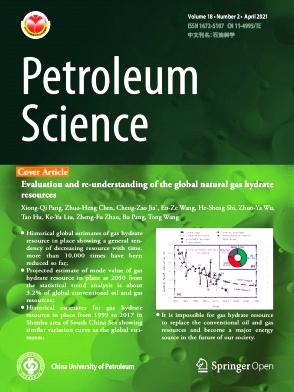地质储碳过程中碳酸反应与致密砂和纯矿物的对比研究
IF 6.1
1区 工程技术
Q2 ENERGY & FUELS
引用次数: 0
摘要
向地质构造中注入二氧化碳已被证明是一种有效的碳储存方法。当溶解在地层水中时,二氧化碳形成碳酸,在酸性条件下诱导孔隙表面的矿物溶解。全面认识碳酸与储层之间的地球化学相互作用对于评价环境对地质构造的影响至关重要。本研究以致密油砂岩油藏为研究对象。在对岩石样品的基本物性和矿物组成进行表征后,分别对岩心和相应的纯矿物样品进行了一系列碳酸腐蚀实验。对实验中收集的溶解溶液进行分析,以检查岩心溶液和纯矿物溶液中离子浓度的变化。研究了碳酸纯矿物的腐蚀动力学。从样品质量、反应速率和离子浓度建立了碳酸与岩心和纯矿物腐蚀情景的相关性。结果表明:腐蚀后,岩石样品中方解石和白云石的质量分别下降了66.7%和27.3%;腐蚀稳定后,芯液中Ca2+和Mg2+的浓度分别为72.9和74.4 mg/L,是Na+的40.5-41.3倍。碳酸-岩石的反应动力学分析表明,在纯矿物腐蚀过程中,碳酸-岩石的反应分为快速反应阶段和缓慢反应阶段,每种离子的反应速率常数和反应顺序不同。通过岩心碳酸反应与纯矿物的对比,建立了一种有效、快速的纯矿物评价碳酸水岩反应的方法,该方法耗时短,便于研究。该研究为地质储碳过程中碳酸腐蚀反应的评价提供了一种简便、快速的方法。本文章由计算机程序翻译,如有差异,请以英文原文为准。
Correlating the carbonic acid reaction with tight sand and pure minerals during geological carbon storage
CO2 injection into geological formations has been proven to be an effective approach for carbon storage. When dissolved in formation water, CO2 forms carbonic acid that induces mineral dissolution at pore surfaces under acidic conditions. Comprehensive understanding of geochemical interaction between carbonic acid and reservoir rocks is crucial for assessing environmental impact on geological formations. This study focuses on a tight oil sandstone reservoir. After characterizing basic petrophysical properties and mineral composition of rock samples, a series of carbonic acid corrosion experiments with both core and corresponding pure mineral samples were carried out, respectively. Dissolution solutions collected during the experiments were analyzed to examine the variations of ion concentrations in both core and pure mineral solutions. The carbonic acid–pure mineral corrosion kinetics were investigated. The correlations between carbonic acid with core and pure mineral corrosion scenarios were established from the sample mass, reaction rate, and ion concentration. The results show that after corrosion, the mass of calcite and dolomite in the rock sample decreased by 66.7% and 27.3%, respectively. When the corrosion was stabilized, the concentrations of Ca2+ and Mg2+ in the core solution were 72.9 and 74.4 mg/L, respectively, which was 40.5–41.3 times higher than that of Na+. The reaction kinetics analysis of carbonic acid–rock revealed a two-stage reaction in the pure mineral corrosion process, rapid reaction stage, and slow reaction stage, with different reaction rate constants and reaction orders for each ion. With the correlation between carbonic acid reaction with core and pure minerals, an effective and rapid evaluation method with pure minerals for the carbonic water–rock reaction is established, which costs a shorter time and is easier to investigate. This study provides a simple and faster method to evaluate the carbonic acid corrosion reaction during geological carbon storage.
求助全文
通过发布文献求助,成功后即可免费获取论文全文。
去求助
来源期刊

Petroleum Science
地学-地球化学与地球物理
CiteScore
7.70
自引率
16.10%
发文量
311
审稿时长
63 days
期刊介绍:
Petroleum Science is the only English journal in China on petroleum science and technology that is intended for professionals engaged in petroleum science research and technical applications all over the world, as well as the managerial personnel of oil companies. It covers petroleum geology, petroleum geophysics, petroleum engineering, petrochemistry & chemical engineering, petroleum mechanics, and economic management. It aims to introduce the latest results in oil industry research in China, promote cooperation in petroleum science research between China and the rest of the world, and build a bridge for scientific communication between China and the world.
 求助内容:
求助内容: 应助结果提醒方式:
应助结果提醒方式:


